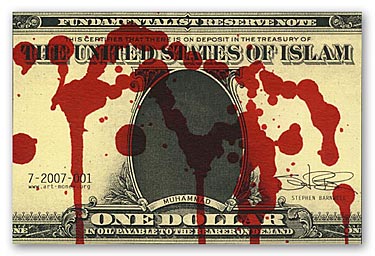Money(art)piece
By Sabine Krangler und Claudia Degold
Symbolic Bloodstains
Printed paper is not always measured with the same value. Especially if it is printed, packaged and distributed by a national bank. Then it has power and value. This potential in explosive force and creative power has captivated many Moneyart artists. They take bank notes as symbols and describe with it the changing |
 |
political scene. They comment on the destructive energy of money, by staining dollar notes with “blood“ or with dictatorial heads of state. “The best way to challenge authority is to steal its voice,” says money artist Stephen Barnwell (50) with determination. Only governments are authorized to create money. He takes their vocabulary and uses it in order to speak out against authority. “I subvert the language of power,” he says to make clear the motivation behind his art.
In 1999, the American created his first “Antarctica four-dollar note“, with his website URL on it. Antarctica was at that time the name of his production company. The former “business cards“ proved to be so popular that he continued with the Seven Dollar note. He eliminated the Web address and turned it into an art project. It took several years until he completed all the denominations of Antarctica Dollars, calling it “my largest and perhaps most popular work to date.” His excursion into the Moneyart genre would probably have ended with this project, if not for the attacks of September 11 and the political consciousness it kindled within him. The work “United States of Islam” was his answer to those events. Connected with that project was the realization that “Moneyart is inherently political,” according to Barnwell. Every artist is a product of his time and reflects it, either consciously or unconsciously. In spite of the still small and very diverse art genre, Barnwell believes in big prospects of success, as political art and satire are very popular not only in America. Among others, his works have been seen in the Palais de Tokyo Contemporary Art Museum in Paris, in the Lahti Art Museum in Finland and in Marin Museum of Contemporary Art in California.
The complete article (in German) - PDF
atello magazine
|